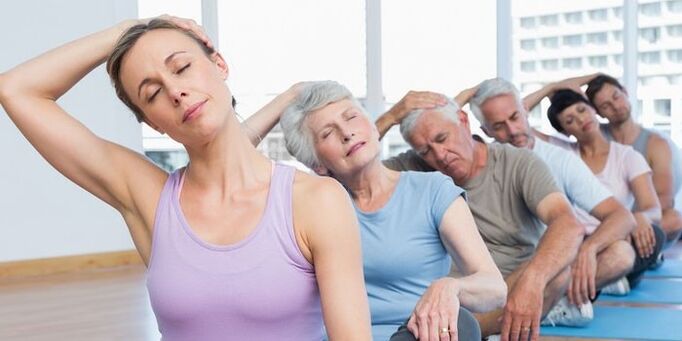Sedentary work, spinal injuries, overweight - there are many reasons for the development of osteochondrosis (dystrophic disorders of the intervertebral discs). Pathological changes develop over the years, gradually manifested by numbness of the hands, burning sensation between the shoulder blades, neck pain and other unpleasant symptoms. If you start exercising on time, you can help yourself.
Benefits of exercise therapy for cervical spine osteochondrosis
Recently, osteochondrosis of the cervical spine was considered an age-related disease, but today the disease is much younger and can occur even in patients aged 20-30 years. It is not possible to completely get rid of dystrophic disorders, but properly selected treatment significantly improves the patient's quality of life. One of the leading places in the treatment of osteochondrosis is the therapeutic and physical training complex (TPC). Simple training has many advantages:
- They help strengthen the muscle corset, increase muscle tone and elasticity of ligaments, thereby significantly reducing the load on the spine.
- Regular exercise eliminates neck pain, headaches, burning sensation between the shoulder blades.
- Gymnastics with cervical osteochondrosis activates blood flow, reduces the likelihood of stroke and increases the supply of oxygen to the brain.
- Classes in the early stages allow you to stop the dystrophic process and improve posture.
Indications and contraindications
Filling with osteochondrosis is prescribed during remission, when pain is reduced. This helps to prevent exacerbations, preventing recurrent pain attacks, complications and further destruction of the joints. Patients with mild spinal cord injury, diabetes mellitus, arterial hypertension should perform the prescribed exercises in a mild version and first only under the supervision of a physician or trainer.
You should not start training immediately after a meal, on an empty stomach or after strenuous physical activity. Physiotherapy exercises are also contraindicated in the following pathological conditions:
- arterial hypertension;
- arrhythmia, tachycardia;
- glaucoma, severe myopia;
- diseases of the vestibular apparatus accompanied by impaired coordination;
- infectious lesion of the spine;
- period of exacerbation of osteochondrosis;
- aortic aneurysm;
- post-infarction condition in the early rehabilitation stage;
- severe spinal injuries;
- acute respiratory viral diseases.

Execution rules
It will be useful to get acquainted with the general rules of physical education before starting gymnastics with cervical osteochondrosis:
- The training should be conducted in a well-ventilated area.
- Training clothes should be loose, not restricting movement and not causing discomfort.
- You should measure your heart rate and blood pressure before classes, and refrain from exercising if they increase.
- To reduce the risk of injury, all movements should be performed smoothly, maintaining your posture by gradually increasing the load, intensity and number of repetitions.
- Gymnastics with cervical osteochondrosis should be performed regularly. Many exercises are suitable to perform at work, while reading.
- If you feel severe pain, dizziness, or get sick during exercise therapy, stop exercising immediately and sit down to rest. Reduce the load in the future and consult a doctor.
- In addition to training, therapeutic massage courses, physiotherapy can be prescribed.
Exercises for cervical osteochondrosis at home
Therapeutic gymnastics involves performing a series of simple exercises. With a doctor's permission, they can be played at home with soothing music. The main condition is that the spine is as flat as possible, so it is preferable to train sitting on a chair without legs or back, rather than lying down. Do gymnastics at the same time every day for a lasting therapeutic effect.
What is warming for?
An important part of any physical activity is muscle training. Mild warming will help you avoid injury, warm up your muscles, prepare your body for intense exercise, and improve blood circulation and stretching. A set of sample exercises:
- Sit in a chair with a straight back, relax and lower your arms along the trunk. Make circular movements with your shoulders, first forward, then backward. Repeat 5-10 times on each side.
- Stay in the same position, spread your arms parallel to the ground. Bend your elbows with an inhalation and gently touch your shoulders with your fingertips. Return to starting position with exhalation. Perform 10 extensions.
- Stand up straight, put your palms on your shoulders, elbows parallel to the ground. With one or two counts, start alternating circular motions with your elbows. First, connect your left elbow to the end of the circle with your right hand. Make 5 circles for each hand.
- Take the starting position as in the first exercise. Squeeze your arms and start moving your shoulders back and forth. Repeat the procedure 10 times for each side.
Isometric exercises for the neck with osteochondrosis
This complex involves performing all the exercises without moving the head or neck - only with muscle tension. Isometric gymnastics is considered the safest for cervical osteochondrosis, so it is prescribed to patients to relieve pain during exacerbation of the disease. All exercises are performed from one position: sitting on a chair without legs or back. The duration of one task is 5 seconds, the number of approaches is 2-5. Examples of effective exercises:
- Tie your fingers together and place your palms on your forehead. Start pressing your hands on your forehead, as if trying to bend your head, resist the neck muscles so that the body does not move.
- Put your hands behind your head in the same position. Press forward with your palms, making a micro movement of the head forward. At the same time, resist the arms with the muscles of the neck and forearm.
- Place your right hand on the side of your cheek with the palm of your hand. Squeeze your hand to your face, trying to tilt your head to the left. At the same time, tighten the muscles, not allowing the head to bend. Do the same exercise with your left hand.
- Get up, spread your legs shoulder-width apart. Hands to the side, palms out. Tighten the neck, arm and back muscles. Squeeze your elbows together, then pull back, trying to pull your hands back as far as possible. Bringing and spreading the elbows is done carefully without removing tension from the muscles and maintaining balance.
dynamic gymnastics
Physical training in cervical osteochondrosis must include exercises aimed at strengthening and increasing the tone of the upper extremities, neck, shoulder girdle and lower back muscles. Dynamic tasks are for that. All are done at high speed, with a 10-15 second break between sets. You should know that dynamic gymnastics is contraindicated in osteochondrosis, diabetes, spinal cord injuries and exacerbations of cardiovascular disease.
Approximate set of exercises:
- Stand up straight, cross your legs, put your hands on your hips. Gently tilt your head and try to reach your shoulders with your ears. Repeat 5-6 times for each side.
- While sitting or standing, slowly raise your hands and bring your palms together. Slowly return to starting position as you breathe. Repeat 10-15 times.
- Stand up, spread your legs apart, and lower your arms along your torso. Do circular rotations with your shoulders at the same time without raising your arms. Move 15 circles in 3 sets. To make it harder, you can do alternate circles - first with the left, then with the right shoulder.
- While standing, pull your right hand back hard, while raising your left hand. Do 10 repetitions and 3 sets for each limb.
- Standing, lower your arms along your torso. Alternatively, do strokes by lifting your shoulders as high as possible and sliding to the sides. Complete the task for 1 minute, then take a break and do 2 more sets.

A set of exercises for osteochondrosis of the cervical spine
Numerous patients of the rehabilitation doctor successfully got rid of hypertension, osteochondrosis and other health problems with the help of exercises for the neck. The doctor claims that his physical training helps to improve blood circulation, develops the muscles of the neck and upper spine, prevents the development of heart attacks and strokes. Gymnastics for cervical osteochondrosis will be useful during rehabilitation after surgery or injury and for people with the following pathologies:
- hypertension;
- drowsiness or insomnia;
- chronic migraine;
- memory impairment.
The author of the technique recommends performing all exercises from a sitting position. It is important to keep your back as even as possible and not in a hurry, otherwise you will not only get positive results, but also worsen your condition. At the initial stage, perform the program in front of a mirror to watch your posture. The training scheme is as follows: the first two weeks - every day, then 3-4 workouts a week.
Therapeutic exercise for cervical lumbar osteochondrosis has certain contraindications. Gymnastics can not be done with:
- increase in body temperature, general malaise, weakness;
- exacerbation of osteochondrosis;
- oncological diseases;
- herniated discs;
- during pregnancy;
- infectious and viral diseases;
- risk of internal bleeding.
7 exercises for neck and shoulder
The complex consists of seven tasks to be performed while sitting in a chair without a back or any other hard surface. All exercises for the treatment of cervical osteochondrosis are shown in the following table:
| The name of the exercise | Initial position | Basic steps | Number of repetitions |
|---|---|---|---|
| spring | Sitting in front of a mirror, arms lowered across the body, head straight. | Pull your chin up to your neck as much as possible. Hold for 20 seconds, then slowly pull your chin forward and up. Return to starting position after 20 seconds. | five |
| Metronom | Sitting in front of a mirror, arms lowered across the body, head straight. | Lower your head to the maximum right. Lock the position for 10 seconds. Slowly return to starting position and repeat the same for the other party. | five |
| A look at the sky | The same | Keep your head straight, keep your chin parallel to the ground. Gently turn your head to the right, correct the position for 10 seconds. Return to starting position and repeat the same for the other party. | five |
| gas | Sitting, arms across the body, chin stretched forward. | From the starting position, gently turn your head to the right and down, trying to reach your chin with your shoulders. Freeze for 10 seconds, then repeat the task for the other party. | 6 |
| Frame | Sit with the right palm on the left shoulder, elbow parallel to the ground. | Bring your chin to the shoulder of your right hand. Hold the position for a few seconds. Return smoothly to starting position. Repeat for the left side. | five |
| Fakir | Hands over palm. | Hold your chin straight and turn your neck to the left. Freeze for 10 seconds, return to start. Repeat the exercise for the left side. | 7 |
| Heron | Sit in a chair with your back straight. | Straighten your arms and palms to the ground. Pull them back as you pull your jaw forward. Hold the body position for 20 seconds. | 4 |
Therapeutic effects and results
Therapeutic exercises for osteochondrosis of the cervical spine help to improve the course of the disease in a short time and treat osteochondrosis with constant performance, without medication. It is not necessary to perform the entire health complex of the proposed exercises immediately, beginners can choose what is given to them without much effort and gradually increase the volume. After achieving therapeutic effects, exercise should not be stopped, the condition should continue to improve.
In the absence of serious contraindications, you can stretch your spine on the horizontal bar. Such an exercise helps to replace the intervertebral discs, gives strength, strengthens the muscle corset. Suitable for swimming, dancing, light fitness, yoga or aerobics. To prevent and fully recover from osteochondrosis, doctors recommend an active lifestyle and proper organization of the workplace.
























